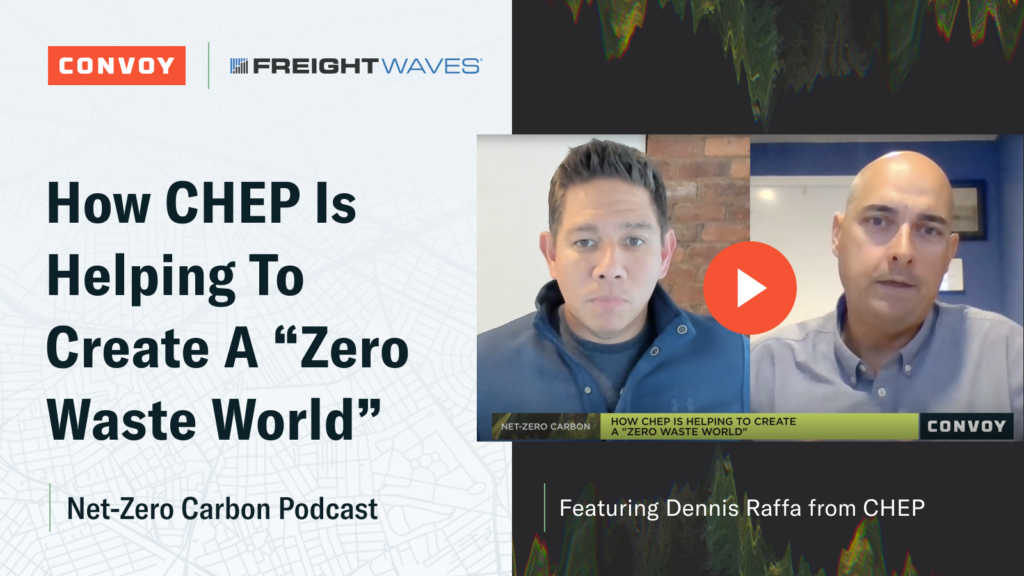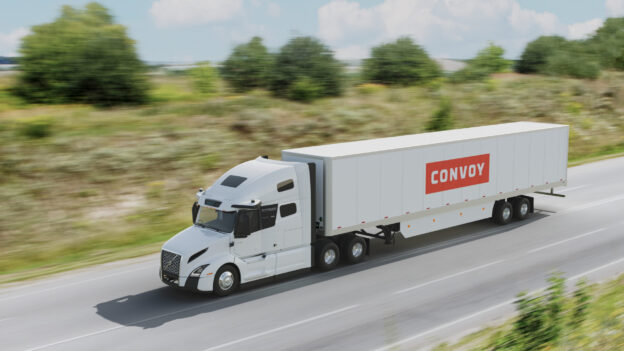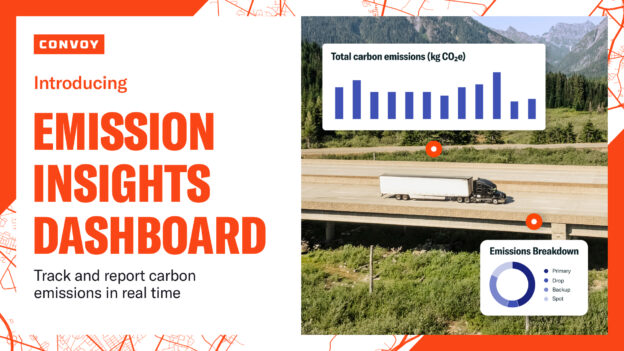How CHEP is Helping to Create a “Zero Waste World”
Shippers, Sustainability • Published on November 22, 2021
Supply chain challenges are currently making headline news, but the massive problem of inefficiencies and waste — which negatively impact the environment — have long been known in the transportation industry.
Danny Gomez, Managing Director of Financial and Emerging Markets at FreightWaves and host of Net-Zero Carbon, recently sat down with Dennis Raffa, Program Lead of the Zero Waste World Initiative in North America for CHEP, to discuss how a pallet company founded in Australia during World War II is actively helping to create a “Zero Waste World.”

Danny and Dennis discussed what CHEP does as it relates to the supply chain, challenges CHEP faces with regard to the supply chain both pre- and post-COVID, and how CHEP and Convoy are partnering to eradicate empty miles and ultimately create a Zero Waste World.
THE CHEP BUSINESS MODEL: CHEP helps customers move the most products and the most platforms across the globe. We are in over 60 countries working with top manufacturers and retailers where we have cooling platforms and regenerative platforms. CHEP was started back in World War II in Australia when the US Army had left pallet platforms, and a gentleman by the name of Walter Brambles had the bright idea of reusing these pallets in the shipping industry. Today CHEP is the global leader in re-leased pallet containers of all sizes. CHEP goes out and issues pallets to raw material suppliers and manufacturers who put products onto the containers and CHEP sends these pallets out to customers who then produce onto them. They will then send them downstream to retailers at the consumer level (if you have you ever been in a Costco or Walmart that blue pallet is a CHEP pallet) and what happens is once the pallet becomes empty of the finished goods, CHEP then collects the pallets in partnership with its retailers and we bring it back to CHEP service centers, inspect them, and then re-issue them again, so we continue to keep those pallets and containers flowing through the supply chain to provide that regenerative process instead of just a one-way asset where at the end of life or at the end of the supply chain it could go to landfill. (3:26)
HOW CHEP ADDRESSES CHOKE POINTS IN THE CURRENT SUPPLY CHAIN: From a reliability perspective, we’ve had our challenges, but we’ve worked with our customers to make sure we have the right products in the right areas to support their demand. We are operating a pooling model, so we’re constantly moving our pallets to different regions. Before the pandemic, we had seasonality issues, and we still do a little bit, but we also have the expertise to get the assets where we need to at specific points in time. If you think about produce season and heavy usage of pallets in the Texas market (south of San Antonio and Houston) and the California Central Valley region, as well as in southern Florida the produce spike is in the summertime where you’re harvesting and into the fall where you’re harvesting, and customers need to get these products across the US. So we’ve developed programs with our customers to get those assets to those areas to supply demand for our customers. We saw the pandemic coming and we’ve seen challenges on the retail side where they’re building inventory sitting on pallets longer and we’ve worked with them to keep those pallets moving in the supply chain. We’ve also brought inventory in so that we had enough inventory to supply the needs for manufacturing of these pallets in our supply chain. I would be lying if I said there weren’t challenges, but we’ve done our best communicating and being transparent with our customers and carriers and being up front with them to help better flow the product through the supply chain. (5:17)
WHAT PROMPTED CHEP TO LAUNCH ITS ZERO WASTE INITIATIVE: The program was launched about two years ago and CHEP has always been doing sustainability and zero waste, but the inflection point for us was what’s next and how are we going to take it to the next level? Two years ago when we launched this program we saw a need from our customers that waste was a problem in the supply chain and they wanted to do better or felt they weren’t doing enough, so we partnered with them to find different types of solutions in the supply chain. We sent a survey out to our customers and the top three things we constantly heard was packaging waste, transport waste, and overall process waste within the supply chain. This program focuses on those three pillars because that’s what the customers have told us is important to them in eliminating waste in their supply chain. As we all know, COVID brought light onto sustainability. There’s more focus on it. I read an article the other day where consumers are willing to pay a little bit more for a sustainable product. You know they’re willing to help the environment and do better. It’s all coming to light as people are starting to question what are you doing here from the consumer level, what are you doing to help the environment, what are you doing to do better and we had a head start two years ago, but COVID has really helped accelerate this program. (8:00)
HOW CHEP IS REDUCING PACKAGING WASTE: We’re teaming up with customers so when they look at reducing their packaging, how is it going to be impacted in the supply chain. When they reduce the plastic packaging or paper packaging that was more robust in the past, and they want to put less plastic in their products, what is that going to do to the product if a driver has to slam on his brakes and the unit load actually shifts in the trailer? It may create product damage so you have stretch wrap around it or you use dunnage (inflatable bags) to keep the product from shifting in the container. So we may be taking packaging out of the product itself but you’re adding additional packaging whether it be through the stretch wrapper, the dunnage, etc. We actually team up with our customers via our innovation center in Orlando where we can test the different types of packaging in the supply chain and see how it reacts in racking, how does it react to different climates, how does it react to vibration, etc., so before you make the packaging change and start shipping, you can see how it will function. The last thing we want is for these great packaging changes to happen and then it gets to the retailer and the load shifted, and there’s more product damaged and then now you have to take it back so you’re adding more transport, more packaging to redo everything, etc. so we look at that with our customers (11:28)
HOW CHEP IS REDUCING TRANSPORT WASTE: From a transport perspective with partners like Convoy, we actually look at where do we have dedicated lanes, where do we have short hauls, long halls, where are there empty lanes both within our supply chain and our customer supply chain where we can team up to fill those empty lanes and eradicate those empty miles. Where are those moves that don’t make sense that we can partner with — and not just with trucks — we are looking at how can we move our pallets into those high demand areas whether it be on barges, intermodal, how do we look at alternative transport that’s going unused or underutilized to capitalize on that? So we’ll team up with our customers and our carriers as well where we have these brainstorming session where we bring in the carrier, we bring in CHEP, and we bring in the customer and all three of us sit down to look to see what are the pain points with those empty miles and let’s do a network overlay and let’s see how we can fix that. (13:00)
HOW CHEP IS REDUCING PROCESS WASTE: From a process perspective, it is no surprise to anyone that labor is at a premium these days, so from a process perspective, it kind of all comes together with transporting packaging waste into the process piece. Customers are changing their packaging, so if there’s that product damaged at the retailer and then they have to resend it to a co-packer to have it reworked, what can we do there to eliminate that extra step in the supply chain from the process perspective so we’re not adding that additional labor. (13:50)
HOW CONVOY AND CHEP PARTNER: Convoy does a good job of leveraging their technology and they are transparent too as a partner and they have some tools like their automated reload process which has been very valuable — especially with COVID — that’s been great from a transparency perspective. Their automated reload process has saved time in the supply chain and has eliminated that waste so we are partnering with them and looking at those empty lanes that I mentioned. Convoy may be running into a customer location, but then that customer is shipping product out and Convoy doesn’t necessarily have the visibility that CHEP does, so in those ideation sessions we bring that data together leveraging Convoy’s technology, CHEP’s technology, and then the customer’s authorization to look at those links. We see if Convoy is going in with a product and then turning around leaving empty. How do we team them up with our customers to haul our goods out and then the customer can use their own fleet or another carrier to move other goods, but then we get that golden triangle. That’s been something that we’ve developed with our carrier partners like Convoy in the supply chain, but it comes back to what they bring from a technology perspective. They’ve also worked with us with some of their products and tools where we’ve actually gotten driver feedback. You’ve mentioned some of the bottlenecks where we didn’t have visibility. We had the driver feedback at the location level where there were long wait times and it helped us raise awareness to a blindspot where we didn’t realize there were long driver wait times at certain service centers, so we were able to quickly identify that with Convoy’s partnership and the driver feedback through their process to go address that immediately and figure out what is the root cause, what is the problem, and how do we fix that to get these drivers moving quickly so that they want to go to a CHEP service center. It helped alleviate a lot of those blind spots so it has proven to be a great partnership with Convoy. (13:50)
HOW CHEP COMMUNICATES ITS PROGRESS ON SUSTAINABILITY AND ZERO WASTE: My vision for this program is to be a conduit in the supply chain. We do a couple of things. We have a life cycle analysis that was created by an independent third party in conjunction with CHEP that looks at the CHEP pallet itself so it’s a life cycle analysis or when our customers use the CHEP pallet what is the benefit that brings? We have a whole solutions team that will go in and do these ideation sessions — someone for transport, someone from supply chain, for packaging on our side, as well as myself, but I come in and tie it all together with those benefits where we measure if it’s a transport piece where Convoy goes in, I mentioned filling those empty lanes so what does that equate to in carbon emission reductions? We actually have a calculator that looks at those carbon emission reductions. Now some of our customers like to use our life cycle analysis, many customers have their own, so we’re willing to work with them to dig into the data behind what ours looks like, what yours looks like, etc. LCAs are becoming very popular these days within the sustainability realm so everyone has one but it’s a preference with how do you use it, what do you want to use it for, so it’s also being transparent and we can get down to the granular level and look at what we are saving on emissions, what are we saving on labor waste, and then how do we get that out there? I want to get the word out that CHEP has pioneered this for a long time, but more and more customers are coming to us for a solution. They ask who can you get me in contact with to solve these issues, how can we partner with Convoy, are other characters out there? What I’ve seen that’s been a little bit unique since COVID is that from a competitor perspective, previously people didn’t want to share ideas with someone else because there’s so much competition, but when COVID hit and everyone was struggling to get goods to a customer, I saw competitors working with each other to deliver goods to the consumer. We can’t do this alone, you have to do it together, and that’s my huge message that I cannot talk about enough. What we need to do is leverage our powers within the supply chain to drive this change and get the word out and quantify it.
ADVICE ON WHERE AND HOW TO START ON A SUSTAINABILITY JOURNEY: There are plenty of networks out there, there’s a lot of data out there, and it can be overwhelming at times. Talk to people you know in your industry, talk to similar customers. CHEP is here to offer up consulting services as well. I work with some of our customers and we have a whole team that will work with our customers who are starting their journey and connect them with some of the folks out there. You can use your own life cycle analysis. I’ve seen it as simple as a spreadsheet that someone’s created because it is the first step of their journey, so they haven’t invested in some of these larger LCAs, but they’re trying to build it out. Lean on CHEP, lean on Convoy who has a team as well that focuses on sustainability. They’ve gone down this path before. I think that’s the one great thing coming from the commercial side of the business over to sustainability, it’s a partnership and everybody wants to help each other out because they want what’s best for the earth. I haven’t seen that in any other role before. Is it COVID? I don’t know, but it’s a change that I’ve seen coming in this role that everybody wants to partner to find out so there are plenty of resources out there. Take it one step at a time. You may stumble, you may get it wrong, but you know we’re here together. I have seen where people presented data and other people have pointed at that data and said, “well I would calculate it this way or I would look at it a different way have you tried this?” and they throw the ideas out there, so don’t be afraid to share your information with others and don’t be afraid to make those mistakes because you’re not going to get where you need to get without making those mistakes, but look at other people too for best practices. (22:40)



